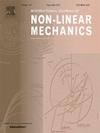Hybrid piezoelectric-electromagnetic energy harvesting from limit cycle oscillation of the wing
IF 2.8
3区 工程技术
Q2 MECHANICS
International Journal of Non-Linear Mechanics
Pub Date : 2025-03-11
DOI:10.1016/j.ijnonlinmec.2025.105082
引用次数: 0
Abstract
As a nonlinear aeroelastic phenomenon, limit cycle oscillation (LCO) of the wing has the potential to supply continuous electrical power output through energy harvesting. In this paper, a basic wing-store structure with hybrid piezoelectric-electromagnetic energy harvesters is proposed to harvest the mechanical energy from bending-torsional coupling LCO response. The nonlinear structure model, the unsteady aerodynamic model and the hybrid energy harvesting model are built and form a piezoelectric-electromagnetic-aeroelastic state-space model. Results show that the extra store at the wingtip can alter the flutter speed and the frequency of the wing. It means that the wing store can lead to LCO response with a higher flutter frequency at lower wind speed. Changing the parameters of the structure and energy harvesting systems can change the intensities and the wind speed range that result in LCO response of the wing. The above features can impact the applicability and electrical power output of the energy harvesting systems. The additional electromagnetic energy harvester can further improve the overall energy conversion efficiency. The details of these effects are demonstrated and the methods for optimizing electric outputs are discussed.
求助全文
约1分钟内获得全文
求助全文
来源期刊
CiteScore
5.50
自引率
9.40%
发文量
192
审稿时长
67 days
期刊介绍:
The International Journal of Non-Linear Mechanics provides a specific medium for dissemination of high-quality research results in the various areas of theoretical, applied, and experimental mechanics of solids, fluids, structures, and systems where the phenomena are inherently non-linear.
The journal brings together original results in non-linear problems in elasticity, plasticity, dynamics, vibrations, wave-propagation, rheology, fluid-structure interaction systems, stability, biomechanics, micro- and nano-structures, materials, metamaterials, and in other diverse areas.
Papers may be analytical, computational or experimental in nature. Treatments of non-linear differential equations wherein solutions and properties of solutions are emphasized but physical aspects are not adequately relevant, will not be considered for possible publication. Both deterministic and stochastic approaches are fostered. Contributions pertaining to both established and emerging fields are encouraged.

 求助内容:
求助内容: 应助结果提醒方式:
应助结果提醒方式:


